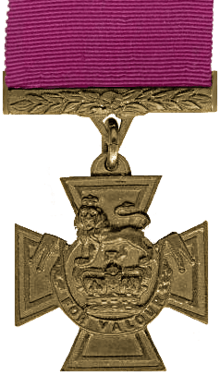Samuel Hill (VC)
| Samuel Hill | |
|---|---|
 | |
| Born |
1826 Glenavy, County Antrim |
| Died |
21 August 1863 (aged 36–37) Meerut, British India |
| Buried at | St John's Cemetery, Meerut |
| Allegiance |
|
| Service/branch |
|
| Years of service | 1844 - 1863 † |
| Rank | Sergeant |
| Unit |
|
| Battles/wars | Indian Mutiny |
| Awards | Victoria Cross |
Samuel Hill VC (1826, Glenavy, County Antrim – 21 February 1863) was an Irish recipient of the Victoria Cross (VC), the highest and most prestigious award for gallantry in the face of the enemy that can be awarded to British and Commonwealth forces.
In 1844 he enlisted in the 67th Regiment of Foot and then transferred in 1856 to the 90th.[1]
He was about 31 years old, and a sergeant in the 90th Regiment (later The Cameronians - Scottish Rifles), of the British Army during the Indian Mutiny when the following deed took place on 16 and 17 November 1857 at Lucknow, India for which he was awarded the VC:
For gallant conduct on the 16th and 17th of November, 1857,, at the storming of the Secundra Bagh at Lucknow, in saving the life of Captain Irby, warding off with his firelock a tulwar cut made at his head by a sepoy, and in going out under a heavy fire to help two wounded men. Also for general gallant conduct throughout the operations for the reliefof the Lucknow garrison. Elected by the non-commissioned officers of the Regiment.
He was killed in action, Meerut, India, on 21 February 1863.
His Victoria Cross medal is in the Tolson Memorial Museum, Huddersfield, Yorkshire.
References
- ↑ Glenavy War Memorials
- ↑ The London Gazette: no. 22212. p. 5514. 24 December 1858. Retrieved 19 September 2009.
Listed in order of publication year
- The Register of the Victoria Cross (1981, 1988 and 1997)
- Clarke, Brian D. H. (1986). "A register of awards to Irish-born officers and men". The Irish Sword XVI (64): 185–287.
- Irelands VCs ISBN 1-899243-00-3 (Dept of Economic Development 1995)
- Monuments to Courage (David Harvey, 1999)
- Irish Winners of the Victoria Cross (Richard Doherty & David Truesdale, 2000)